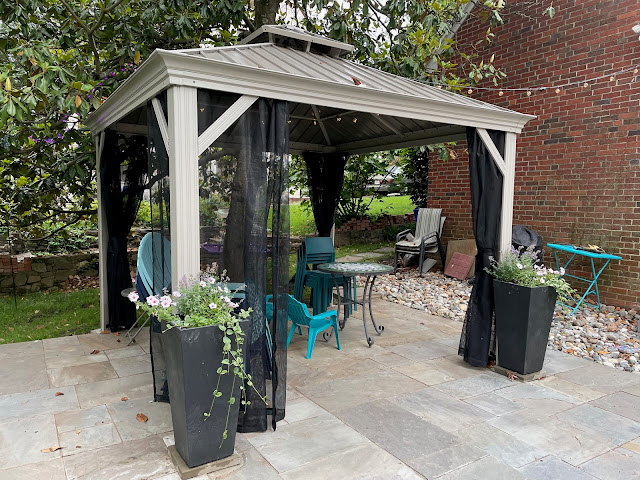To continue from last week's post about our gazebo, I thought I'd go past the rest of the building part, which meant fitting the dozens of panels into the roof frame and cupola frame and bolting them in--because really what else is there to say about that--and talk about how we anchored and decorated it.
Because this gazebo has a vented cupola, it has an escape valve for windy weather and is at less risk of blowing away. Of course that doesn't mean we should trust it to fate. We decided to bolt one pair of legs to concrete blocks that we dug into the ground and anchor the two that sat on the patio with heavy flower pots. So step one: dig a hole (actually, step one was to shopping for the supplies was step one). We bought and glued together two concrete retaining wall blocks for this leg. At 22.4 lb. each, that seemed like a good additional amount of weight. The other leg only has one block because we hit a tree root and didn't want to damage it. It still seemed pretty good. Getting it level to the patio took some time, and we did not bolt the leg to it right away, to give us a chance to adjust if everything settled. To actually bolt the leg to the block, D used a hammer drill, which was a new one for us. It hammers the bolt in while turning, and is for exactly this kind of very strong material.
Then it was time to deal with the other legs, that would sit on the patio. For these, we bought 12'' x 12'' pavers and shopped around for thin, tall, heavy flower pots. That turned out to be a challenge, because most people prefer light, easy-to-maneuver flower pots. Or super expensive flower pots. We ended up deciding on ones made from recycled tires--less environmental impact AND heavier than resin and plastic.
Then we put some bricks at the bottom, for good measure, loaded it up with dirt, and found some pretty flowers to plant: cat's meow, petunias, and vinca vines.
Then after obsessing over trying to find the perfect light to hang from the hook in the center of the gazebo (long-time readers might remember that I LOVE fancy lighting from here, here and here), we found what we decided was an even better solution: a fan! It plugs in, which is perfect, since obviously we don't have an electrical box out there. At the time we purchased it, it was the only option. A second decent-looking choice has since come back into stock that might be a little better, but now we've already committed. The fan has been great at helping to cool us off and to help keep bugs away from us and our food when we're dining al fresco.I also added what I thought was a nice touch with some decorative pebbles in whites and sea-glass blues. We love seeing the bees enjoy our new flowers too.
 |
| Pollinator friendly! |
Next up was getting some electricity and mood lighting into the gazebo. After thinking of all sorts of complicated ways we could try to run an electric under the ground in PVC pipe (and then reading lots of warning about why you should never do that with cheap, non-professional wiring), we decided for the most obvious route--above our heads.
After reading a bunch of string light reviews and learning that pretty much every option will fill with water eventually (and therefore stop stressing about finding the perfect solution), I decided on bulbs filled with little fairy lights. Instead of a single lightbulb inside each bulb, they contain a strand of lights. We strung them up along the cord leading into the gazebo and all around the ceiling. We love them!










No comments:
Post a Comment